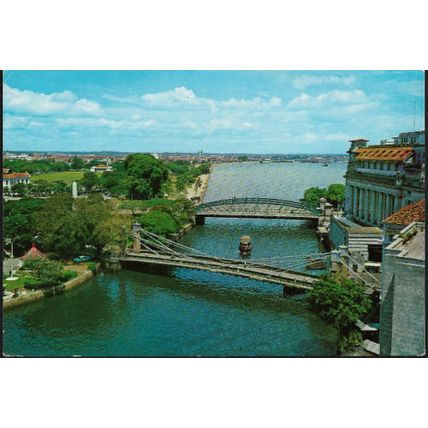Singapore - Cavenagh & Anderson Bridges - postcard by SW - postcard c.1970s
- Condition : Used
- Dispatch : 2 Days
- Brand : None
- ID# : 213030625
- Quantity : 1 item
- Views : 131
- Location : United Kingdom

- Seller : justthebook (+1703)
- Barcode : None
- Start : Mon 21 Nov 2022 07:11:34 (EDT)
- Close : Run Until Sold
- Remain : Run Until Sold
Checks/Cheques
 for 1 item(s) edit
for 1 item(s) edit
Shipping Calculator
More Listings from This Seller view all
Seller's Description
- Postcard
- Picture / Image: Cavanagh [sic, actually Cavenagh] & Anderson Bridges, Singapore
- Publisher: SW No. S128
- Postally used: no
- Stamp: n/a
- Postmark(s): n/a
- Sent to: n/a
- Notes / condition:
Please ask if you need any other information and I will do the best I can to answer.
Image may be low res for illustrative purposes - if you need a higher definition image then please contact me and I may be able to send one. No cards have been trimmed (unless stated).
------------------------------------------------
Postage & Packing:
Postage and packing charge should be showing for your location (contact if not sure).
No additional charges for more than one postcard. You can buy as many postcards from me as you like and you will just pay the fee above once. Please wait for combined invoice. (If buying postcards with other things such as books, please contact or wait for invoice before paying).
Payment Methods:
UK and all other locations - PayPal or other methods listed above.
NOTE: All postcards are sent in brand new stiffened envelopes which I have bought for the task. These are specially made to protect postcards and you may be able to re-use them.
I will give a full refund if you are not fully satisfied with the postcard.
----------------------------------------------
Text from the free encyclopedia WIKIPEDIA may appear below to give a little background information (internal links may not work) :
*************
Cavenagh Bridge is the only suspension bridge and one of the oldest bridges in Singapore, spanning the lower reaches of the Singapore River in the Downtown Core. Opened in 1869[1] to commemorate Singapore's new Crown colony of the Straits Settlements status in 1867, it is the oldest bridge in Singapore that exists in its original form.
Originally known as the Edinburgh Bridge to commemorate the visit of the Duke of Edinburgh, its name was changed to Cavenagh Bridge in honour of Major General Orfeur Cavenagh, the last India-appointed Governor of the Straits Settlements, who governed from 1859 to 1867.[2] The coat of arms of the Cavenagh family can still be seen atop the signage at both ends of the bridge.
Cavenagh Bridge linked the Civic District on the northern bank to the Commercial District on the southern bank of the Singapore River. Before Cavenagh Bridge was constructed, people could only move between the two districts via a detour over Elgin Bridge or by paying 1 duit (¼ cent) for a boat ride across the river.
This bridge has elaborate suspension struts in comparison with most other suspension bridges, and is the third bridge to be built in Singapore. It was constructed in 1869 to allay the inconvenience of crossing the Singapore River by boat. Numerous steel rivets were used in its construction, which employed steel casting methods commonly used during that era.
The bridge was designed by the colonial Public Works Department's John Turnbull Thomson and constructed by the P&W Maclellan, Glasgow Engineers at a cost of Straits $80,000. Built and tested in Glasgow to withstand a load four times its own weight, it was shipped to Singapore in parts and reassembled in 1869 by convict labour before opening to traffic a year later. Rickshaws and ox carts used the Cavenagh Bridge to cross Singapore River. Subsequently, the bridge became overloaded due to the flourishing trade on the Singapore River in the late 1880s.
Cavenagh Bridge is currently a pedestrian bridge, with lighting added in 1990 to accentuate its architectural features at nightfall.[2] It now provides the most convenient pedestrian link between the cultural district at the north bank and the commercial district to the south of the Singapore River, and complements the renovated Fullerton Hotel (previously Fullerton Building) which is sited beside the bridge.
There are numerous sculpture works near the Cavenagh Bridge, including a family of Singapura cats (kucinta or drain cats), recognised as one of the smallest breeds of cats in the world, located at the southwest abutment.
On 3 November 2008, the bridge was selected for conservation as part of the Urban Redevelopment Authority's expanded conservation programme. It was subsequently upgraded to a national monument, planned in the early 2010s and announced in 2019 by Deputy Prime Minister Heng Swee Keat. The historical significance is the old police signboard and the physical bridge where Singaporeans had walked past through, even during Lee Kuan Yew's lying-in-state on March 2015.[1][3][4][5]
Anderson Bridge is a pedestrian bridge that spans across the Singapore River. It is located near the river's mouth in the Downtown Core Planning Area of Singapore's Central Area.
The bridge was completed in 1910,[1] and was named after the Governor of the Straits Settlements and High Commissioner for the Federated Malay States (1904–1911), Sir John Anderson, who officially opened the bridge on 12 March 1910.[2] It forms part of the Singapore Grand Prix's Marina Bay Street Circuit, which debuted on 28 September 2008.
Anderson Bridge was built under oversight of Municipal Engineer Robert Peirce with the intention to replace the overloaded Cavenagh Bridge as the link between the government administrative area in the Civic District on the northern bank and the Commercial District (now Raffles Place) on the southern bank of the Singapore River. Due to the flourishing trade on the Singapore River by the 1880s, Cavenagh Bridge could not support the increasingly heavy traffic into town. Despite the building of Ord Bridge and Read Bridge, the traffic situation did not improve and in fact worsened following the widening of Battery Road. Its low draught was also insufficient for the passage of boats at high tide. However, when Anderson Bridge was completed in 1910, Cavenagh Bridge was spared from demolition and was converted to a pedestrian bridge, with all vehicles being diverted to Anderson Bridge.
Anderson Bridge was constructed between 1908 and 1910, as a joint venture between the colonial government and the Municipality after the reclamation of the south bank of the Singapore River. Construction of bridge cost £50,000 and was carried out by Howarth Erskine Ltd while the abutments were built by the Westminster Construction Company Limited.[2][3]
The bridge comprises three steel arches with supporting steel ribs extending across them, two rusticated archways and a fluted pier at each end.
During the Japanese Occupation of Singapore (1942–1945), the severed heads of criminals were hung on Anderson Bridge as a warning to discourage citizens from breaking the law.
Anderson Bridge today
Anderson Bridge, as seen from Queen Elizabeth Walk.
In the 1990s, due again to the increasing vehicular traffic flow between the northern and southern bank of the Singapore River, the Esplanade Bridge was built to provide faster access between Marina Centre and the financial district of Shenton Way. Construction of the 260-metre-long (850 ft) bridge in front of the mouth of the Singapore River began in early 1994 and was completed in 1997.
Anderson Bridge currently still serves as a vehicular bridge, and connects the financial district directly to City Hall. The bridge is located near The Fullerton Hotel (previously Fullerton Building) and the Former Merlion Park. It also forms a distinctive part of the F1 Singapore Street Circuit.
On 3 November 2008, the bridge was selected for conservation as part of the Urban Redevelopment Authority's expanded conservation programme.[4]
On 15 October 2019, the National Heritage Board gazetted the Anderson Bridge, along with Cavenagh Bridge and Elgin Bridge (collectively known as the Singapore River Bridges) as the 73rd National Monument of Singapore.[5][6] This was first announced by Deputy Prime Minister Heng Swee Keat on 3 August 2019, where the Padang is included as a future National Monument.[7][8]
On 5 November 2021, authorities announced the conversion of Anderson Bridge to full pedestrianization from end December 2021, to increase the Civic District's walkability. The bridge was later converted to a pedestrian bridge, with all vehicles being diverted to Esplanade Bridge again.[9]
Listing Information
| Listing Type | Gallery Listing |
| Listing ID# | 213030625 |
| Start Time | Mon 21 Nov 2022 07:11:34 (EDT) |
| Close Time | Run Until Sold |
| Starting Bid | Fixed Price (no bidding) |
| Item Condition | Used |
| Bids | 0 |
| Views | 131 |
| Dispatch Time | 2 Days |
| Quantity | 1 |
| Location | United Kingdom |
| Auto Extend | No |




















